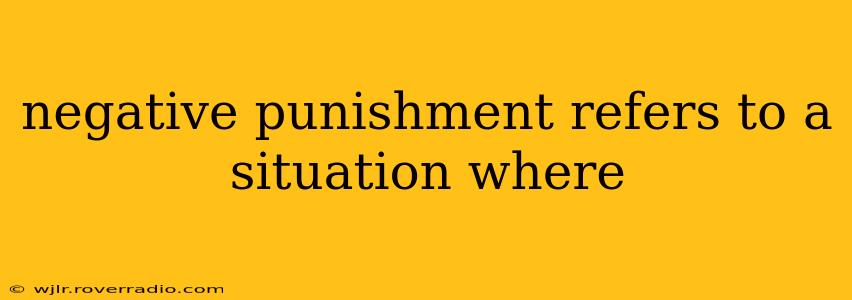Negative punishment refers to a situation where a reinforcing stimulus is removed following a behavior, resulting in a decrease in the likelihood of that behavior occurring again. It's crucial to understand that "negative" in this context doesn't mean bad or harmful; it simply means the removal of something. This contrasts with positive punishment, which involves adding an aversive stimulus to decrease a behavior.
Negative punishment is a powerful tool for behavior modification, but it needs to be implemented carefully and ethically. Unlike positive punishment, which can often lead to fear and aggression, negative punishment aims to gently decrease unwanted behaviors by taking away something desirable. Let's explore this in more detail.
What are some examples of negative punishment?
Negative punishment manifests in various ways, depending on the specific behavior and the individual involved. Here are some common examples:
- Time-out: Removing a child from a reinforcing environment (like playtime with friends) for a short period after misbehavior. This removes access to positive reinforcement.
- Loss of privileges: Taking away a teenager's phone or access to video games after breaking a rule. The privilege (reinforcer) is removed to decrease the likelihood of the rule-breaking behavior repeating.
- Grounding: Restricting a child's activities and social interactions for a specific period following a transgression. This limits access to various reinforcers, such as socializing with friends or engaging in preferred activities.
- Forfeiting a reward: A student loses extra credit points after missing an assignment. The potential reward (extra credit) is removed.
- Ignoring attention-seeking behaviors: Parents ceasing to respond to a child's tantrums or whining. The attention (reinforcer) is removed, aiming to reduce the frequency of the tantrums.
How is negative punishment different from positive punishment?
This is a frequently asked question, and understanding the difference is vital for effective behavior modification.
Negative Punishment: Removes a desirable stimulus to decrease the likelihood of a behavior.
Positive Punishment: Adds an undesirable stimulus to decrease the likelihood of a behavior.
For instance, taking away a child's favorite toy (negative punishment) is different from spanking the child (positive punishment). Both aim to decrease a behavior, but they use opposite methods. Positive punishment often has unintended negative consequences, potentially leading to fear, aggression, and anxiety. Negative punishment, when properly implemented, is generally considered a more humane approach.
How effective is negative punishment?
The effectiveness of negative punishment depends on several factors:
- Consistency: The removal of the reinforcer must be consistent and immediate following the undesirable behavior. Inconsistent application can confuse the individual and reduce the effectiveness of the technique.
- Timing: The closer the removal of the reinforcer is to the behavior, the more effective it will be.
- Appropriate reinforcer: The removed stimulus must actually be a reinforcer for the individual. Removing something irrelevant won't have an impact.
- Ethical considerations: It's crucial to ensure that the removal of the reinforcer doesn't create harm or distress. The removal should be proportionate to the behavior and should not infringe on basic needs.
What are the potential downsides of negative punishment?
While generally considered a milder approach than positive punishment, negative punishment can have drawbacks:
- Avoidance behaviors: Individuals may attempt to avoid situations where the reinforcer might be removed, potentially leading to more complex behavioral issues.
- Emotional distress: While less likely than with positive punishment, the removal of a valued reinforcer can still cause emotional upset.
- Difficulty in identifying reinforcers: Determining what constitutes a reinforcer for an individual can be challenging.
Is negative punishment cruel?
The potential for cruelty lies not in the method itself, but in its application. When implemented correctly, focusing on removing specific, easily identified reinforcers in a consistent and timely manner, it can be a humane and effective method of behavior modification. However, removing essential needs or using excessively harsh methods constitutes abuse and is never ethical.
In conclusion, negative punishment, when applied thoughtfully and ethically, can be a valuable tool for shaping behavior. However, it's crucial to understand its nuances, potential drawbacks, and ethical implications to ensure its responsible and effective use. Always consider consulting a professional, such as a behavior analyst or therapist, for guidance on managing complex behavioral issues.
